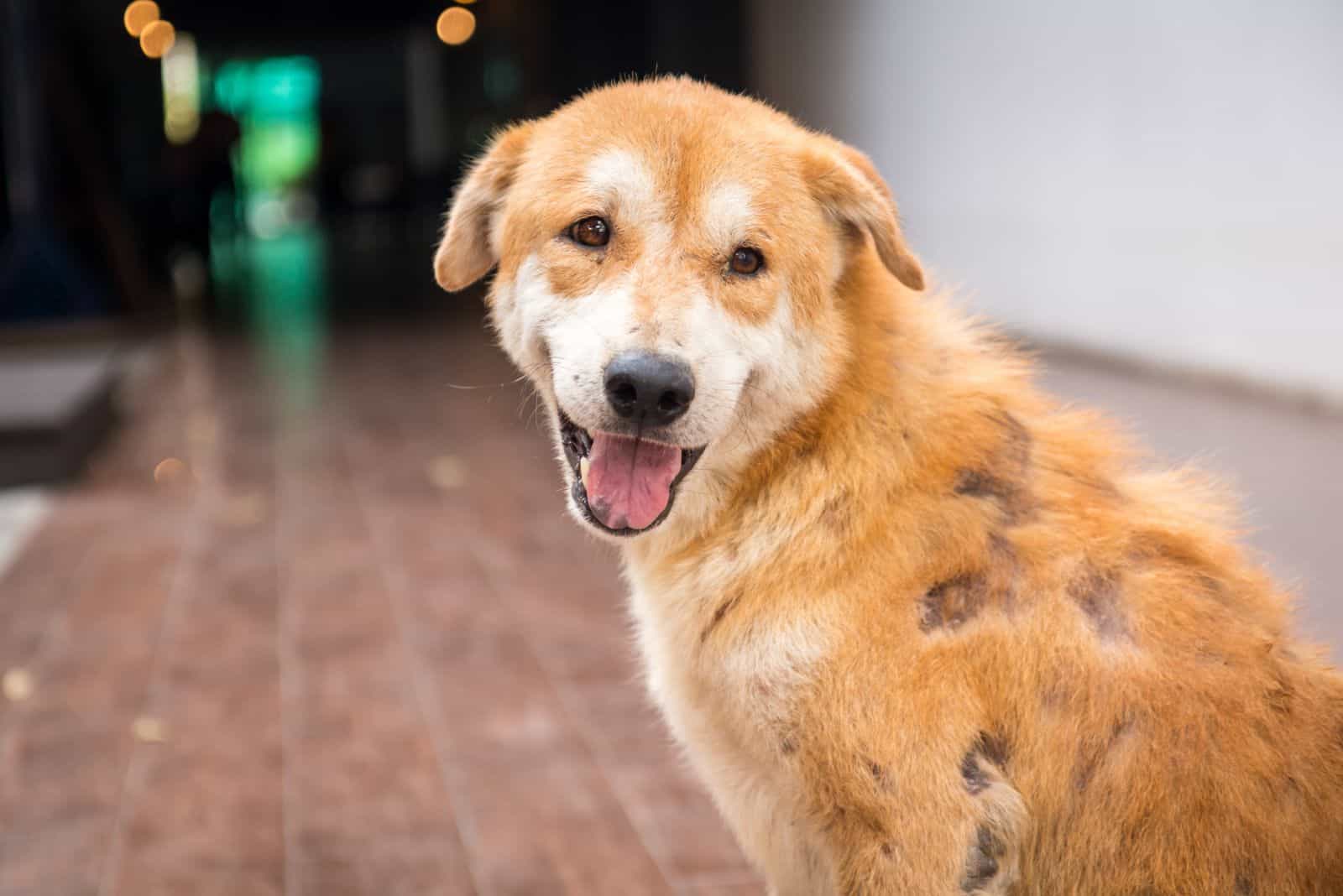If you’ve ever seen one of those pictures online with dogs suffering from mange, you probably shudder at the very mention of the word. However, like any responsible dog owner, you definitely want to be prepared and know just how to treat mange in dogs at home.
Hopefully, you will never need to do this, but it’s always better to be prepared.
Mange is a skin condition in dogs caused by mites that can lead to skin irritation, inflammation, and hair loss. While treatment with a veterinarian is important, there are several home remedies that can be effective in managing the condition.
In this article, we will explore the top seven home remedies for treating mange in dogs. These mange remedies can be used in conjunction with prescribed medications to eliminate the mange.
We will also discuss when it is necessary to see a veterinarian and when other treatment options may be necessary.
How To Treat Mange In Dogs At Home
Mange is a common skin condition in dogs that is caused by tiny mites that burrow into the skin and cause irritation, inflammation, and eventually hair loss.
While there are several types of mange, the most common is demodectic mange, which is caused by Demodex mites and is not contagious to humans or other animals. Sarcoptic mange, on the other hand, is highly contagious and can be transmitted to humans and other animals.
Mange can be treated successfully with the right treatment plan, and in many cases, it can be done at home.
In this article, we will provide a step-by-step guide on how to treat mange in dogs at home using a combination of medications, home remedies, and good hygiene practices.
We will also discuss when to see a veterinarian and when to consider more aggressive treatment options.
Home Remedies For Mange
There are several home remedies that can be used to treat mange in dogs.
One of the most effective home remedies is to mix equal parts of water and white vinegar and use it to rinse the affected areas on your dog’s skin. This can help to kill the mites and soothe the skin.
You can also try using various oils, such as coconut oil or olive oil as a natural treatment for mange. These oils contain fatty acids that can help to kill the mites and moisturize the skin.
Another home remedy is to use a mixture of equal parts of honey and water. Honey has natural antibacterial and anti-inflammatory properties that can help to kill the mites and reduce inflammation.
Those are just a few examples and we will be discussing each of them (and others) in more detail in the following paragraphs.
It is important to note that these home remedies should be used in conjunction with medications prescribed by a veterinarian in order to fully eliminate the mange.
1. Apple Cider Vinegar

To use apple cider vinegar to treat mange in your dog, follow the steps outlined below.
Firstly, dilute the vinegar with water by mixing one part vinegar with three parts water.
Clean your dog’s skin gently with a mild dog shampoo to remove any dirt and debris.
Then apply the apple cider vinegar mixture to your dog’s skin. Use a cotton ball or a spray bottle to apply the mixture to your dog’s affected areas. Avoid getting the mixture in your dog’s eyes, ears, and mouth.
Make sure to massage the mixture into your dog’s skin. Gently massage the mixture into your dog’s skin, making sure to reach all affected areas.
Repeat the process every day. Continue to apply the apple cider vinegar mixture to your dog’s skin every day until the mange is gone. This may take several weeks.
It is important to remember that apple cider vinegar is only a home remedy and may not work for all cases of mange. If your dog’s condition does not improve after a few weeks of treatment, or if your dog is experiencing severe symptoms, it is important to consult a veterinarian for proper treatment.
2. Honey
Honey has amazing medicinal qualities and can treat a wide range of conditions in both humans and animals. In fact, honey is included as an ingredient in a number of dog food products.
The sensitive, delicate skin can heal because of its antibacterial and antioxidant characteristics, which will also aid develop immunity. Honey can also rid the skin of bacteria and mange-related filth and grime.
For treatment, directly apply honey to the skin lesions on your dog. Although untidy, this procedure may be beneficial.
However, you should keep in mind that using honey to treat mange in dogs is not 100% effective and should not be considered a cure.
In some cases it could even potentially delay proper treatment, leading to further discomfort for the dog and potentially worsening the condition.
If you suspect that your dog has mange, it is important to consult a veterinarian as soon as possible.
The veterinarian will be able to diagnose the condition and recommend the appropriate treatment, and you can also ask them about the possibility of honey treatment.
3. Olive Oil

Olive oil can help soothe sensitive skin and possibly get rid of mange mites by being applied directly to the affected regions.
Here are some steps you can follow to use olive oil to treat mange in your dog:
Clean the affected area. Before applying any treatment, it is important to clean the affected area thoroughly. Gently wash the area with mild soap and water, and pat it dry with a clean towel.
After that, you are ready to apply the olive oil. Once the area is clean, apply a small amount of olive oil to the affected area using a clean cotton swab or your finger. Massage the oil into the skin, being careful not to get it in your dog’s eyes or mouth.
Repeat the treatment once or twice a day until the mange clears up. It is important to be consistent and patient, as it may take several weeks for the mange to completely clear up.
Pay close attention to your dog’s behavior and appearance, and report any changes or concerns to your veterinarian. If the mange does not improve or gets worse, your veterinarian may need to adjust the treatment plan.
4. Hydrogen Peroxide And Borax
Mange is commonly treated by giving your dog a bath in a solution of Borax and hydrogen peroxide. Combining Borax and hydrogen peroxide may aid in the removal of mange mites and the healing of skin ulcers.
Regular use of these remedies may help your dog get rid of mange, and weekly application may prevent a recurrence.
The best course of action would be to consult a veterinarian if the issue is not getting better because there are extremely effective medications available to treat it.
5. Aloe Vera
Aloe vera plant extracts have been utilized by some dog owners to cure mange.
The discomfort and irritation that mange mites create on the skin can be lessened with the aid of aloe vera extract. Additionally, it demonstrates a few minor antibacterial properties that might aid in preventing infections from developing.
Aloe vera extracts are said to also kill ectoparasites, however, we haven’t been able to discover a reliable source to back up this claim. It is possible that any thick liquid, gel, or paste could suffocate mites that are residing on your dog’s skin.
Until the mange clears up, aloe vera extracts are often administered to the affected areas a few times each week. As a result, this is a home remedy that is only effective for localized mange infestations, similar to olive oil therapy.
Additionally, you must stop your dog from swallowing aloe vera extracts because they are poisonous to them. Of course, this is easier said than done. During this time, you might need to fit your dog with a training collar.
Dogs who consume aloe vera typically have vomiting or diarrhea, though occasionally depression and muscle spasms can also happen.
6. Yogurt

Another well-liked natural treatment for mange is yogurt. The majority of owners who use it to cure mange just spread it on the affected region.
If yogurt works, it will probably be because it suffocates the majority of the mites on your dog’s skin. Although this has not yet been scientifically shown, it probably benefits the skin a little bit and the probiotics it contains may help remove the fungus that is present on your dog’s skin.
Therefore, there is no reason why you can’t try yogurt on dogs who have mild, localized mange. It might not work, but it shouldn’t result in many significant skin issues.
7. Lemon
Certain lemon juice and water concoctions are occasionally advised for treating canine mange. They are often applied topically to the afflicted area.
However, you’re typically looking at a whole lemon or two in a liter or two of water, depending on the source you consult. These mixes occasionally have garlic added.
The idea is that the acidity of the final mixture will kill the mites that are now dwelling on your dog’s skin. Given that many citrus fruits are known to have antiseptic characteristics, it might also help to get rid of some of the germs or fungi that are already there.
Lemon juice may or may not have the desired effect because there is a significant variation between how it behaves in theory and how it behaves on your dog’s skin.
Although your dog is unlikely to consume much lemon juice and it is not harmful, it could result in irritated skin. As many of the helpful bacteria that are present on your dog’s skin will probably be eliminated, it could even make existing skin conditions worse.
In general, we advise against owners attempting this specific home treatment, as there are many better alternatives.
How Effective Are Home Remedies For Mange?
There are several home remedies that can be used to treat mange in dogs, but it is important to note that these remedies may not be as effective as prescription medications.
Mange is a skin condition caused by mites, and it is important to get a proper diagnosis and treatment plan from a veterinarian to ensure that the condition is properly treated.
It is important to follow the treatment plan recommended by your veterinarian, as home remedies may not be effective in treating all types of mange. If you are unsure about using a home remedy to treat your dog’s mange, it is always best to consult with a veterinarian.
Over-The-Counter Dog Mange Treatments

If you are unable to obtain a mange medication or an anti-parasitic shampoo from your vet, you may want to consider purchasing an over-the-counter mange treatment for your pet.
There are basically three different types of over-the-counter mange treatments available. We’ll discuss each type below.
It is important to note that these over-the-counter treatments should be used in conjunction with a veterinarian-prescribed treatment plan in order to fully eliminate the mange.
It is also important to follow the recommended dosing and frequency of use as indicated on the product label. If the condition does not improve or if you have any concerns, it is always best to turn to professional veterinary care.
Shampoos
There are several steps you can follow to treat mange in dogs with shampoo.
Firstly, you should choose a medicated shampoo specifically designed for mange treatment. These shampoos often contain active ingredients such as benzoyl peroxide, or amitraz, which can help to kill the mites and reduce inflammation.
To start, wet your dog’s coat thoroughly with warm water. Then apply a small amount of the shampoo to your dog’s coat, starting at the head and working your way down to the tail. Be sure to avoid getting the shampoo in your dog’s eyes.
Massage the shampoo into your dog’s coat for several minutes to ensure that it reaches the skin and the mites. Allow the shampoo to sit on your dog’s coat for at least 10-15 minutes to give the active ingredients time to work.
After 10-15 minutes, rinse your dog’s coat thoroughly with warm water to remove all of the shampoo, and finally, towel dry your dog’s coat or allow it to air dry.
It is important to follow the recommended dosage and frequency of use as indicated on the product label. You may need to repeat this process every few days until the mange is fully cleared.
Medications
There are a few OTC treatments for mange that you might want to look into.
The majority of over-the-counter drugs for canine mange are created with different plant oils and are unlikely to be effective treatments. However, some of them may contain sulfur, which in many instances seems to work.
When administering this kind of medication, you must exercise caution to keep it out of your pet’s eyes. Before applying this medication to your dog’s entire body, it is advisable to test it on a very small patch of skin on its body to ensure that it won’t irritate its skin.
Flea Treatments
When treating mange in dogs with over-the-counter flea treatments, you should choose a flea treatment specifically designed for mange treatment.
These products often contain active ingredients such as fipronil or selamectin, which can help to kill the mites and prevent re-infestation. At the very least, they will help get rid of fleas and ticks.
Always make sure to follow the instructions on the product label for proper application. Most flea treatments are applied to the back of the neck or between the shoulder blades.
Pay special attention to the dosage instructions for your dog’s size and weight. It is important to use the correct dosage to ensure the effectiveness of the treatment.
Repeat the treatment according to the recommended frequency. This is typically once a month for ongoing prevention.
Monitor your dog closely for any adverse reactions to the treatment. If you notice any unusual behavior or symptoms, stop the use of the product immediately and consult with a veterinarian.
It is important to use these products as directed in order to effectively treat the mange and prevent re-infestation. If the condition does not improve or if you have any concerns, it is always best to consult with a veterinarian.
It’s always good to get pet advice from someone with DVM next to their name.
Should I Take My Dog To The Vet If It Has Mange?
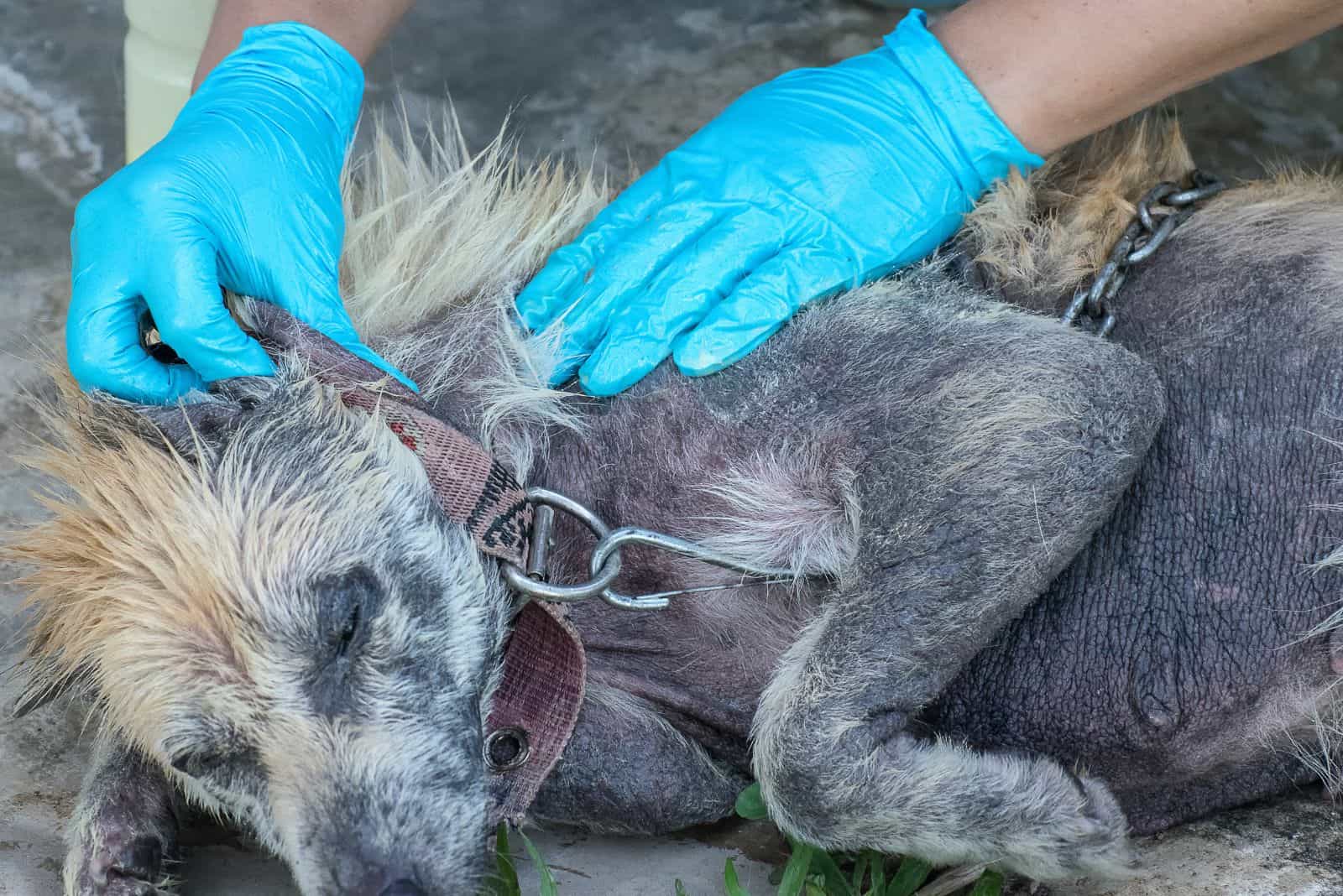
Yes, it is important to take your dog to the vet if it has mange.
Mange is a skin disease caused by mites, and it can cause extreme itchiness, hair loss, and skin infections.
The vet will be able to diagnose the type of mange your dog has and recommend the best treatment. In some cases, treatment may include medications or other therapies to kill the mites and improve your dog’s symptoms.
It is important to get treatment for mange as soon as possible to prevent the condition from becoming more severe and to help your dog feel more comfortable.
What Is Dog Mange?
We’ve mentioned this several times throughout the article, but now is the time to describe in detail what mange really is and how it comes about.
Mange is a skin problem in dogs that is caused by mites. It is typically diagnosed by skin scraping.
In the dog’s skin, these mites lay their eggs, which develop into larvae before becoming adult mange. Usually what happens afterward is a horrible mange reproduction cycle.
Owners typically become aware of the issue when they see patches of skin damage or missing hair, but that is far from being the only symptom.
Are There Different Types Of Mange?
There are several types of mange, including demodectic mange, sarcoptic mange, and cheyletiella mange.
All three have their own distinct ways of affecting the dog, and we will be discussing each of them in the sections that follow.
In all cases, it is important to take your dog to the vet for proper diagnosis and treatment of mange.
Sarcoptic Mange
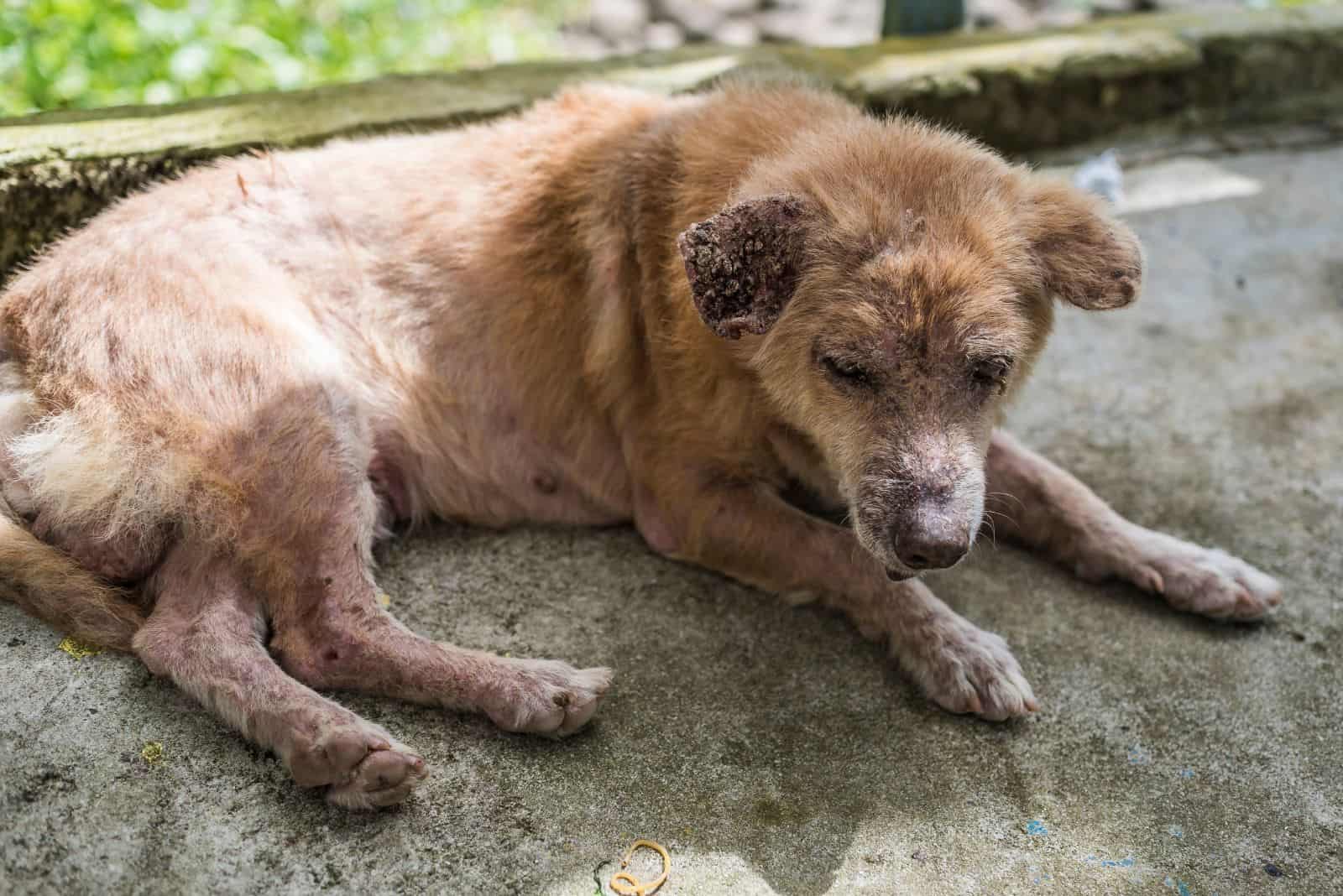
Sarcoptic mange, also known as scabies, is caused by a type of mite called Sarcoptes scabiei, or simply sarcoptic mites.
These mites burrow under the skin and cause severe itching, redness, and crusting of the skin. Sarcoptic mange is highly contagious and can be transmitted to other dogs and even to humans.
Symptoms of sarcoptic mange in dogs may include:
- Intense itching and scratching
- Redness and irritation of the skin
- Crusty or scaly skin
- Hair loss, particularly on the ears, elbows, and belly
- Thickened, thick, or raised skin lesions
Sarcoptic mange can affect dogs of any age, breed, or size, but it is more common in puppies and in dogs with weak immune systems.
If left untreated, sarcoptic mange can lead to secondary infections and can cause severe discomfort for your dog.
It is important to take your dog to the vet as soon as possible if you suspect that they have sarcoptic mange so that they can receive proper treatment. The vet will typically prescribe medications to kill the mites and relieve your dog’s symptoms.
It is also important to practice good hygiene and to thoroughly clean and disinfect your dog’s bedding and environment to prevent the mites from spreading.
Demodectic Mange
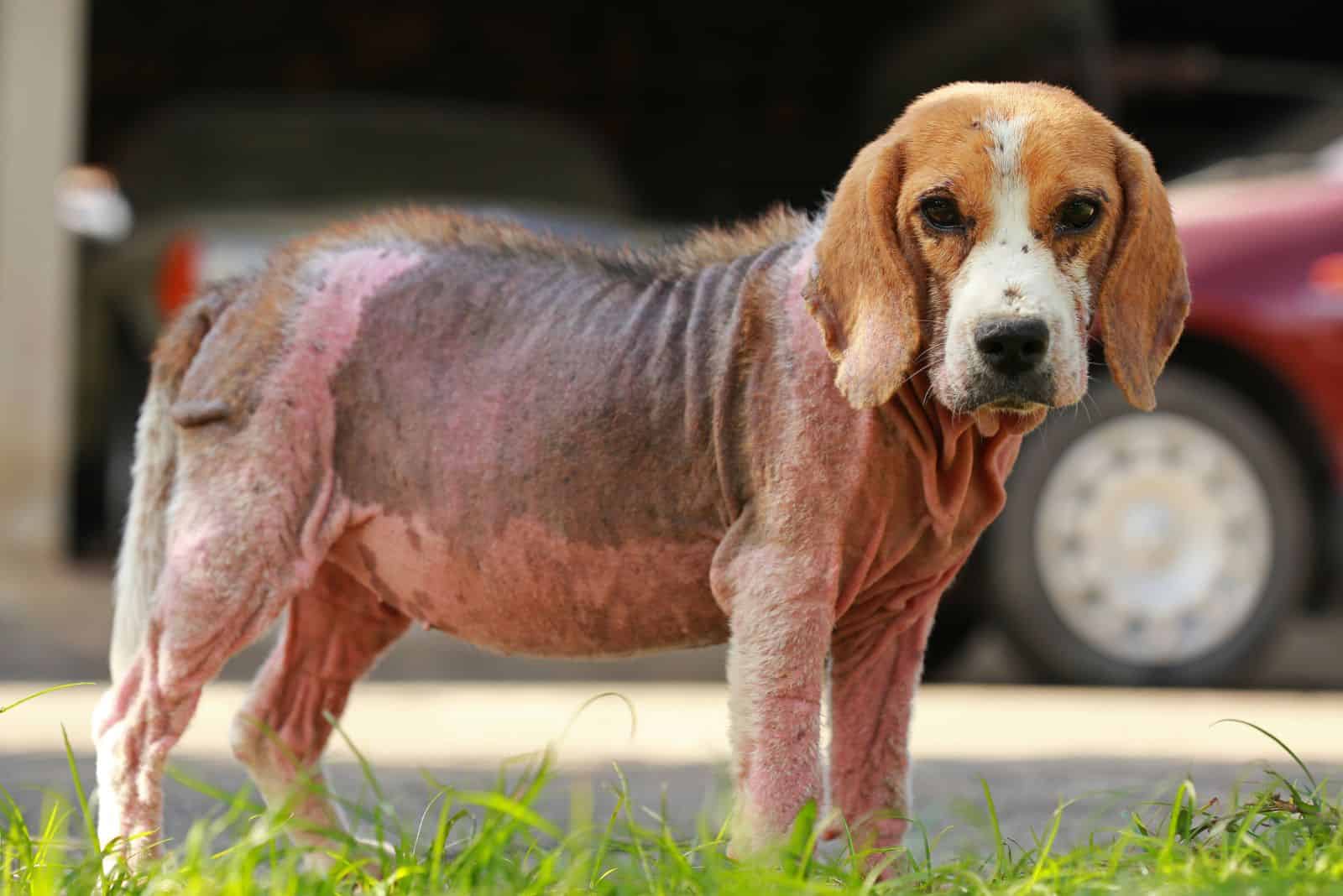
Demodectic mange, also known as demodicosis or red mange, is caused by a type of mite called Demodex canis, commonly referred to as demodectic mites.
These mites are normally found on the skin of dogs, but they can multiply and cause a skin infection when a dog’s immune system is weakened or when the mites are overpopulated.
Demodectic mange is usually seen in young dogs and can cause hair loss, redness, and scaling of the skin.
There are two types of demodectic mange: localized demodicosis and generalized demodicosis.
Localized demodicosis affects a small area of the skin, typically on the face or legs, and is more common in younger dogs. It is often self-limiting and will resolve on its own.
Generalized demodicosis, on the other hand, affects a larger area of the skin and is more severe. It is more common in older dogs and in dogs with compromised immune systems.
Symptoms of demodectic mange may include:
- Hair loss, often in patches around the elbows and armpits
- Redness and irritation of the skin
- Scaling and crusting of the skin
- Pustules or papules (small bumps or pimples)
- Thickened or raised skin lesions
If your dog has demodectic mange, it is important to take them to the vet for proper diagnosis and treatment. The vet will typically prescribe medications to kill the mites and improve your dog’s symptoms.
In some cases, treatment may also include supportive care such as medicated baths or changes to your dog’s diet. It is important to follow the vet’s treatment plan and to bring your dog back for follow-up visits to ensure that the condition is properly resolved.
Cheyletiellosis Mange
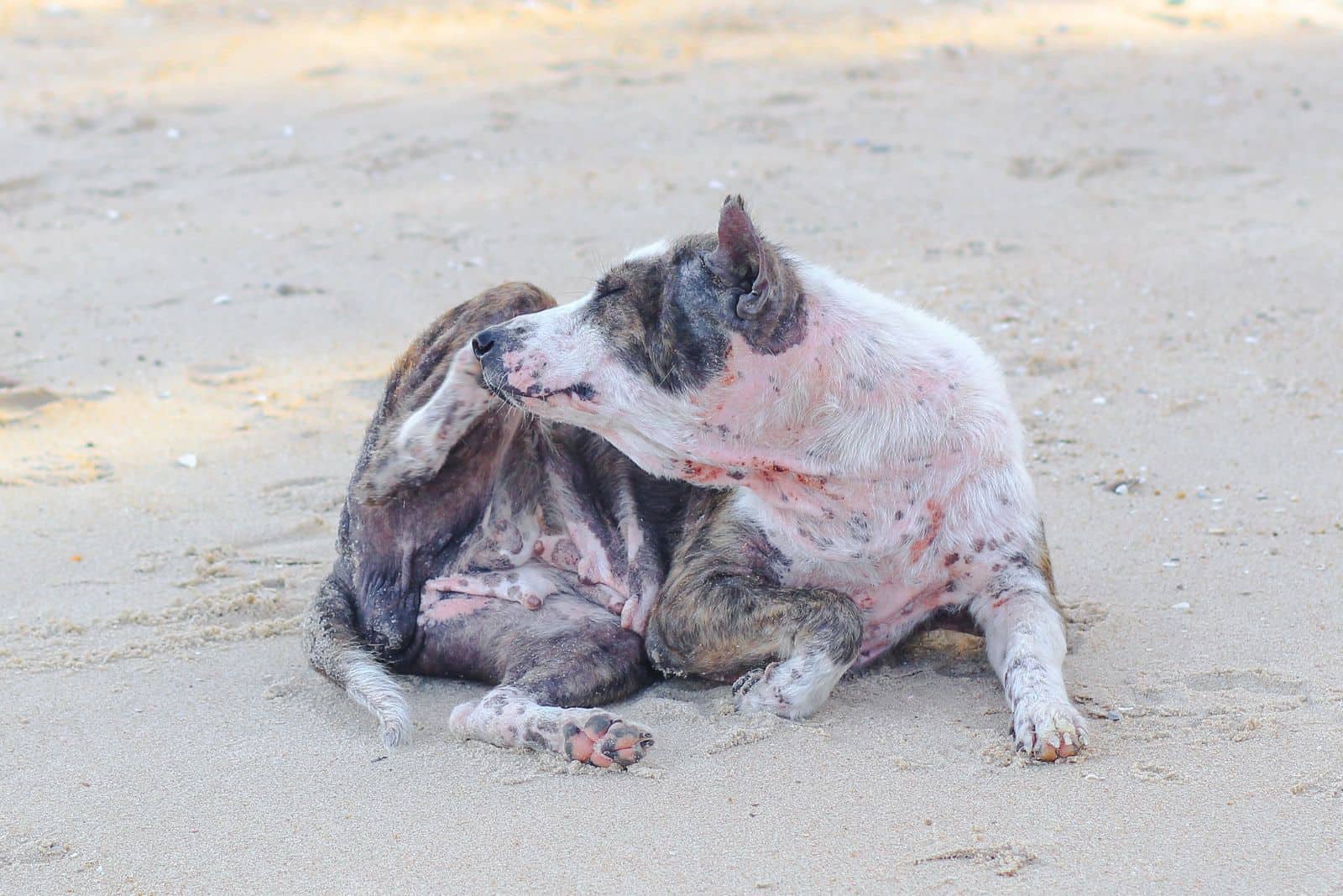
Cheyletiellosis mange, also known as walking dandruff, is caused by a mite called Cheyletiella yasguri.
These mites live on the surface of the skin and cause dandruff-like scales, itching, and redness. Cheyletiellosis mange is also contagious and can be transmitted to other dogs and cats through close physical contact or by sharing bedding, toys, or other objects.
It can also be transmitted to humans, although it is not a common cause of mange in people.
Symptoms of Cheyletiella mange may include:
- Dandruff-like scales on the skin, particularly on the back and neck
- Itching and scratching
- Redness and irritation of the skin
- Bald patches or thinning of the fur
What Are The Symptoms Of Mange In Dogs?
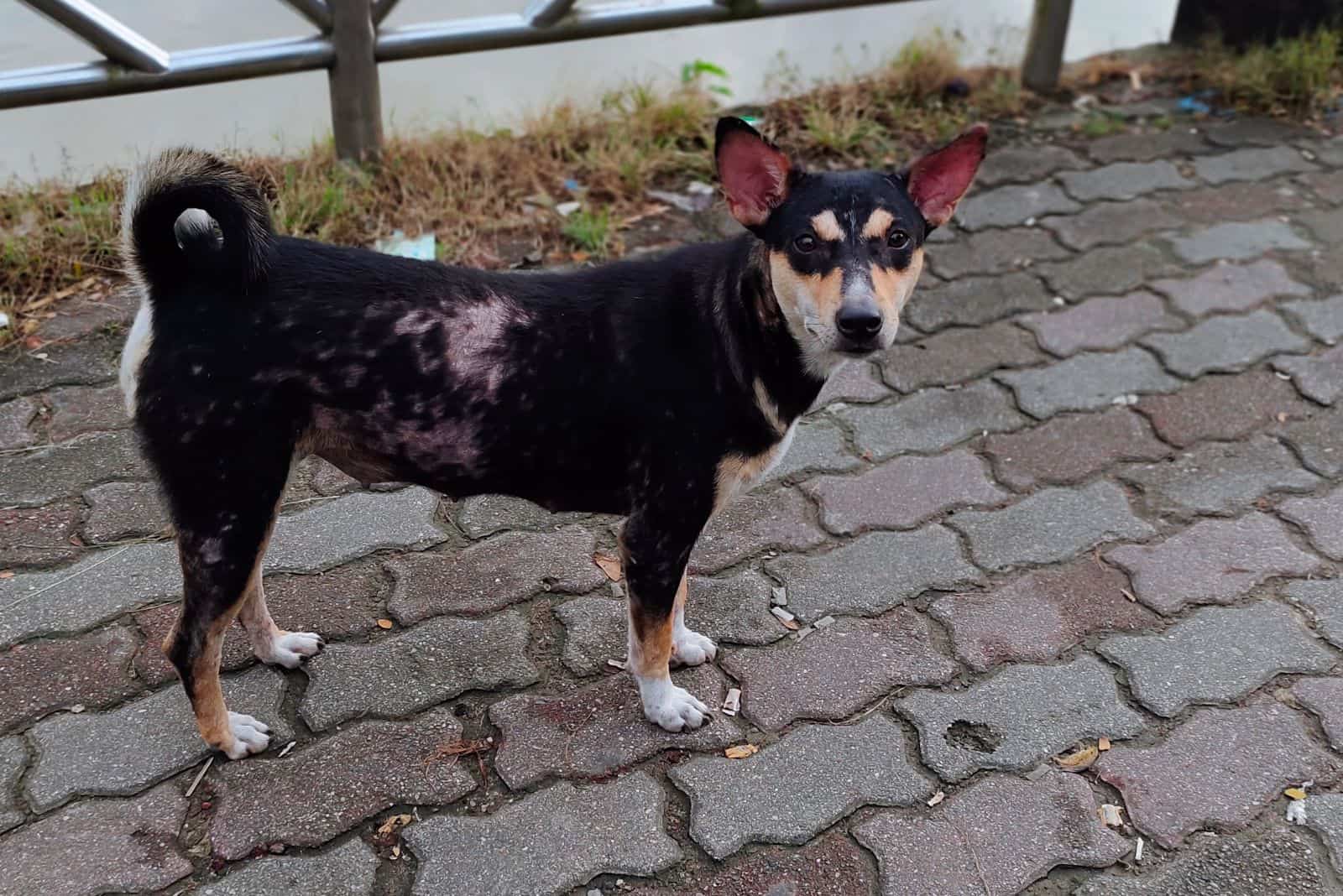
The symptoms of mange in dogs can vary depending on the type of mange and the severity of the condition. However, common symptoms of mange in dogs may include:
- Intense itching and scratching
- Redness and irritation of the skin
- Hair loss, particularly in patches
- Scaling, crusting, or thickening of the skin
- Pustules or papules (small bumps or pimples)
- Thickened or raised skin lesions
If your dog is showing any of these symptoms, it is important to take them to the vet as soon as possible for proper diagnosis and treatment.
The vet will be able to determine the type of mange your dog has and recommend the best course of treatment. It is important to get treatment for mange as soon as possible to prevent the condition from becoming more severe and to help your dog feel more comfortable.
Are Some Dog Breeds More Susceptible To Mange?
Some dog breeds may be more susceptible to certain types of mange than others, but any dog can develop mange if they are exposed to mites.
Demodectic mange, which is caused by the Demodex mite, is more common in certain breeds such as American Staffordshire Terriers, Bull Terriers, Dachshunds, and Boxers.
These breeds may have a genetic predisposition to developing demodectic mange, especially if they are young or have a compromised immune system.
Sarcoptic mange, which is caused by the Sarcoptes scabiei mite, can affect any dog of any breed, age, or size. However, it is more common in puppies and in dogs with compromised immune systems.
Cheyletiella mange, which is caused by the Cheyletiella mite, can also affect any dog of any breed, age, or size. However, it is more common in long-haired breeds and in crowded or stressed environments such as shelters or breeding facilities.
It is important to note that all dogs are at risk of developing mange if they are exposed to mites, regardless of their breed.
Is Mange Contagious?
Yes, some types of mange in dogs are contagious to other dogs and even to humans.
Sarcoptic mange is highly contagious and can be transmitted from dog to dog through close physical contact or by sharing bedding, toys, or other objects. It can also be transmitted to humans, although that is not nearly as common.
Cheyletiella mange is also contagious and can be transmitted from animal to animal, but also from animal to human.
Demodectic mange, on the other hand, is usually not contagious to other dogs or to humans. These mites cannot complete their full life cycles on the human skin, and therefore are not considered dangerous.
However, demodectic mange can be transmitted from mother to puppy during the first few weeks of life.
Is Mange Fatal For Dogs?
Mange is a treatable skin disease in dogs, and it is generally not fatal if it is diagnosed and treated in a timely manner.
However, if left untreated, mange can cause severe discomfort for your dog and can lead to secondary infections or other complications. In rare cases, these complications can lead to death if they are not treated.
It is important to take your dog to the vet as soon as possible if you suspect that they have mange so that they can receive proper treatment.
The vet will be able to diagnose the type of mange your dog has and recommend the best course of treatment, which may include medications or other therapies to kill the mites and improve your dog’s symptoms.
It is also important to follow the vet’s treatment plan and to bring your dog back for follow-up visits to ensure that the condition is properly resolved. With proper treatment, most dogs with mange will make a full recovery and will not experience any long-term effects.
However, it is crucial to continue to practice good hygiene and to prevent your dog from coming into contact with infected animals to help prevent re-infection.
What Happens If Mange Is Left Untreated?
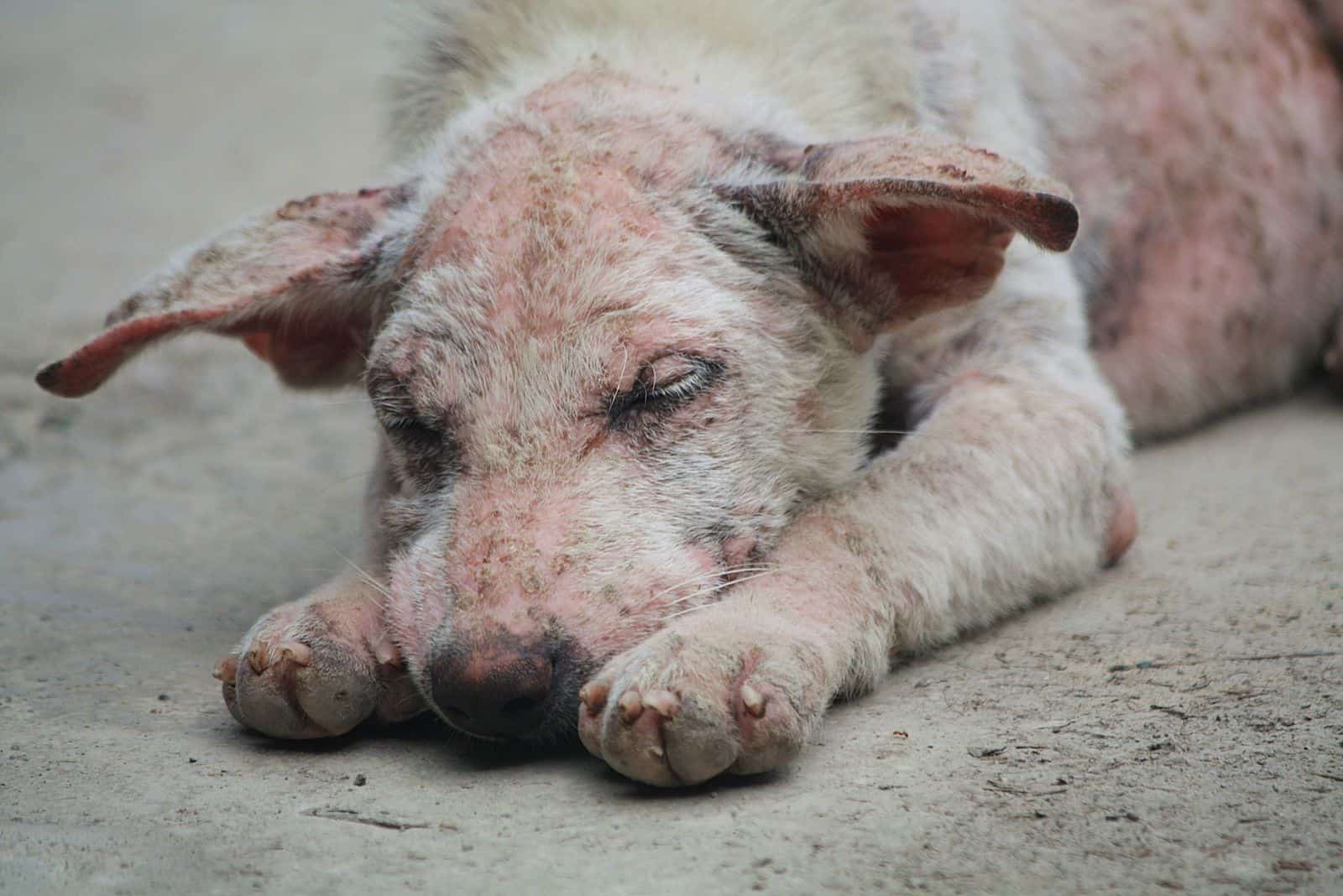
If mange is left untreated, it can lead to a variety of serious health issues for your dog. Mange is caused by tiny mites that burrow into the skin and cause irritation, inflammation, and eventually hair loss.
Without treatment, the mites can continue to multiply and spread, leading to a worsening of the condition.
Untreated mange can also lead to secondary infections of the skin, as the irritated and inflamed skin is more prone to bacterial infections. These infections can be painful and may require additional treatment with antibiotics.
In severe cases, mange can cause your dog to lose a significant amount of hair follicles, leading to bald patches and a lack of insulation for the body. Unless it’s already a hairless breed.
This can make your dog more vulnerable to the elements and can potentially lead to other health problems such as hypothermia.
Overall, it is important to prioritize your dog’s health and seek treatment as soon as possible to ensure the best possible outcome.
Bacterial and Fungal Infections
Most dogs will scratch constantly as a result of the mange’s acute itching. This may irritate your dog’s skin and cause scabs, as well as bacterial and fungal infections, which will make the healing process more challenging.
Some common bacterial infections that can arise as a result of mange include pyoderma, cellulitis, and impetigo.
Pyoderma is a bacterial skin infection that is characterized by the presence of pustules or abscesses on the skin.
Cellulitis is a deeper bacterial skin infection that can cause swelling, redness, and warmth in the affected area.
Impetigo is a contagious bacterial skin infection that is characterized by the presence of red sores or blisters on the skin.
Some common fungal infections that can arise as a result of mange include ringworm and dermatophytosis.
Ringworm is a fungal infection that affects the skin and is characterized by the presence of circular, red patches on the skin.
Dermatophytosis is a fungal infection that affects the skin, hair, and nails and is characterized by the presence of scaly, itchy lesions on the skin.
It is important to seek treatment for secondary infections as soon as possible to prevent the condition from worsening and to ensure the best possible outcome.
Treatment may include the use of antibiotics or antifungal medications, as well as good hygiene practices.
Zoonotic Potential
Zoonotic potential refers to the ability of a disease or condition to be transmitted from animals to humans. Some diseases, such as mange, can be transmitted from animals to humans, while others cannot.
There are several types of mange, and some types have a higher zoonotic potential than others. Sarcoptic mange, for example, is highly contagious and can be transmitted to humans and other animals. Demodectic mange, on the other hand, is not contagious to humans or other animals.
It is important to take proper precautions to prevent the transmission of diseases and conditions with zoonotic potential.
This may include washing your hands after handling infected animals, avoiding contact with infected animals, and following proper hygiene practices.
If you are concerned about the zoonotic potential of a disease or condition, it is always best to consult with a veterinarian or a healthcare professional.
How Long Does It Take To Treat Mange At Home?
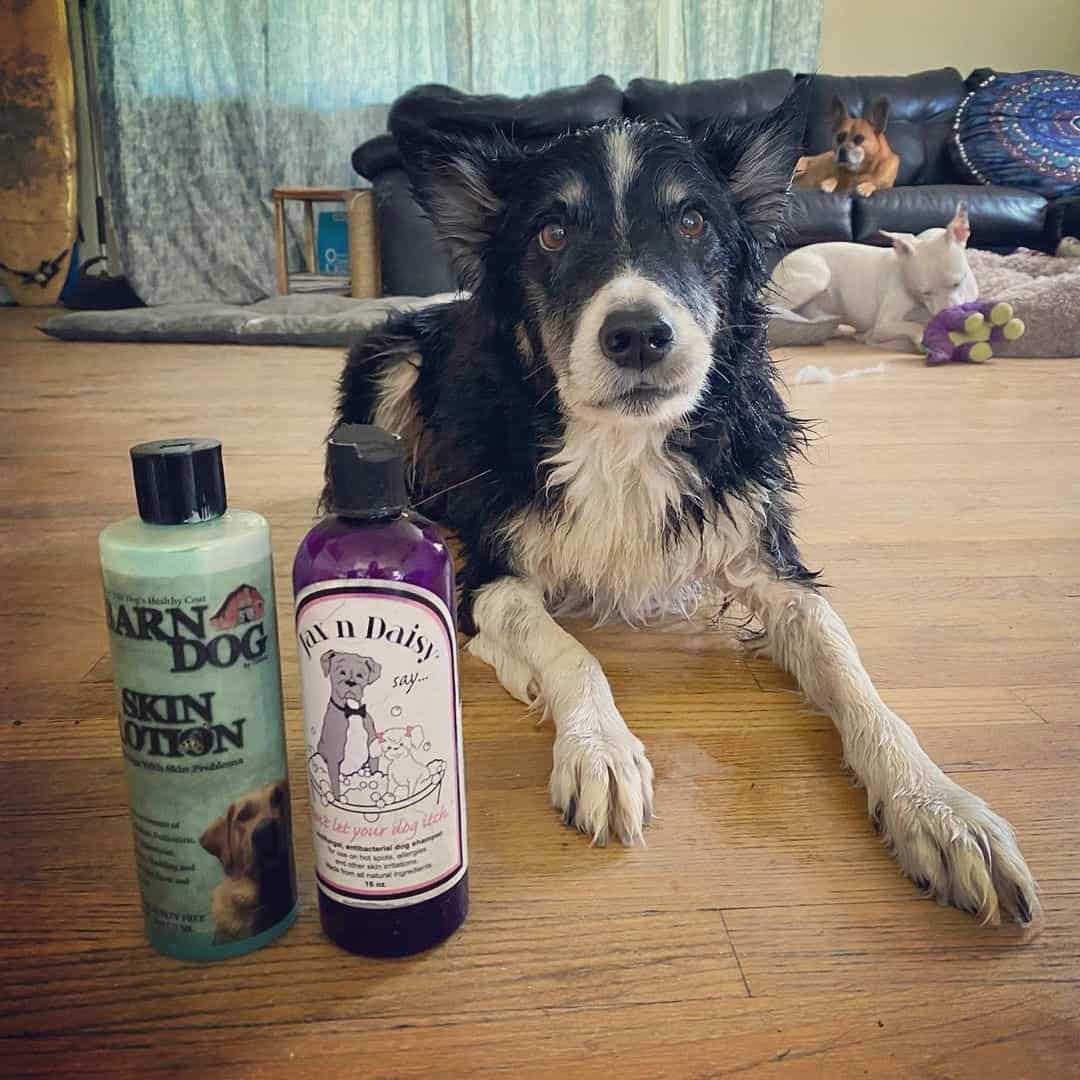
The length of time it takes to treat mange in dogs at home will depend on several factors, including the severity of the condition, the type of mange, and the effectiveness of the treatment plan. In general, it can take several weeks to several months to fully eliminate mange.
It is important to follow the recommended treatment plan and to see a veterinarian if the condition does not improve or if more aggressive treatment options are necessary.
The use of medications and home remedies in conjunction with good hygiene practices can help to speed up the recovery process.
It is also important to be patient and consistent with treatment. It may take time for the mites to be completely eliminated and for the skin to fully heal.
However, with proper treatment, it is possible to successfully eliminate mange and improve your dog’s overall health and well-being.
What Is The Fastest Way To Cure Mange?
The fastest way to cure mange in dogs is to follow a comprehensive treatment plan that includes the use of medications and home remedies in conjunction with good hygiene practices.
Below are some general steps you can take to help speed up the recovery process.
Use a medicated shampoo or topical treatment specifically designed for mange treatment. Don’t just pick up any old bottle of human shampoo. These specialized products can help to kill the mites and reduce inflammation.
Follow the recommended treatment plan as prescribed by a veterinarian. This may include the use of medications such as ivermectin, which is effective in killing the mites.
Use home remedies to soothe the skin and kill the mites. Options include the use of vinegar, olive oil, and honey.
Furthermore, you should always practice good hygiene by regularly washing your dog’s bedding, toys, and other items to prevent re-infestation.
During the treatment, make sure to monitor your dog closely for any changes in its condition and report any concerns to a veterinarian.
Another thing that we should probably mention is the procedure of neutering or spaying your dog. There is research that suggests that these operations decrease the risk of many diseases in dogs, including mange.
But if you don’t want to spay or neuter your dog, for one reason or another, you can basically just follow all the tips that we’ve already laid out in this article and be patient.
You need to understand that there isn’t an overnight cure and that these things take time.
You will need to be persistent and keep providing the treatments for weeks, and sometimes even months, if the case is particularly severe.
Conclusion
In conclusion, mange is a common skin condition in dogs that can be treated effectively with the right combination of medications and home remedies.
If you’ve ever wondered how to treat mange in dogs at home, then this post should have answered a lot of your questions.
The seven home remedies discussed in this article, including the use of white vinegar, olive oil, and honey, can help to kill the mites and reduce inflammation.
It is important to follow the recommended treatment plan and to see a veterinarian if the condition does not improve or if more aggressive treatment options are necessary.
By properly treating mange, you can help to alleviate your dog’s discomfort and improve their overall health and well-being. Overall, it is important to prioritize your dog’s health and seek treatment as soon as possible to ensure the best possible outcome.
